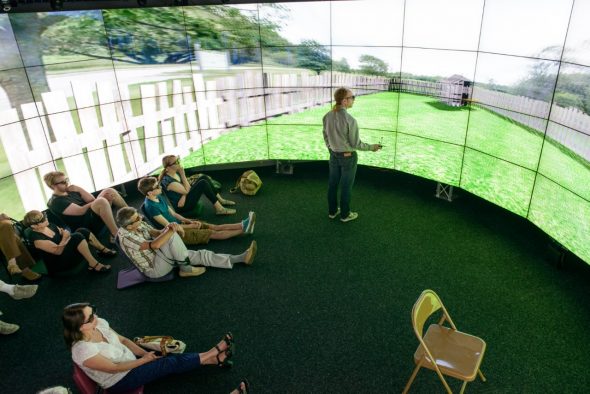UIC’s Electronic Visualization Lab is helping reimagine live stage performance
By Andrea Poet
Imagine attending a play and having the ability to take control of the narrative, shaping the direction of the story. Or think about going to a theatrical event that is taking place simultaneously in two locations, and being able to interact with not only the theatergoers in the other location but together in a virtual, shared environment.
Daria Tsoupikova, associate professor of new media design at UIC, is working with her colleagues in UIC Computer Science’s Electronic Visualization Laboratory (EVL), the Goodman Theatre, and Jo Cattell, a Chicago-based theater producer, to create and stage this innovative, interactive experience for Chicago youth from underserved West and South Side communities.
“Kids may not have a lot of experience with theater, but most have a lot of experience with gaming, especially on their mobile devices. We want to instill an appreciation for live performance and engage them in the theater,” said Tsoupikova.
This collaboration is enabled by a $150,000 University of Illinois Presidential Initiative to Celebrate the Impact of the Arts and the Humanities, and was one of 14 projects selected earlier this year to share in nearly $2 million in funding. The project, “Transforming Storytelling: Multi-User Virtual Reality Theater for Collaborative Tele-Immersive Exploration” includes Tsoupikova, Cattell, Andrew Johnson, associate professor in the computer science department; Lance Long, EVL’s director of research; and Arthur Nishimoto, a PhD student in computer science at UIC. Both Design and Computer Science students will help with the grant.
“This is the most fun grant I’ve ever participated in, by far,” Tsoupikova said. “How do you enhance the story? It’s very different. In interactive applications, you delegate the control to the user. How do you orchestrate that in live theater, and make it a meaningful experience?”
In this tele-immersive theater, audience members will meet on a virtual stage inside the play and interact with each other, with actors and with the storyline. Participants can communicate with one another using sound, movement, and gestures. In some cases, images will be used; in others, physical objects will be present and morph into virtual things — if an audience member touches a real egg, it may transform into a virtual dragon and fly off.
Either virtual reality headsets or head-mounted displays, along with other augmented and mixed-reality devices, will connect audience members and actors who will be located in one of two physical spaces: the Goodman Theatre’s new 10,000 square-foot Alice Rapoport Center for Education and Engagement, home to the Goodman’s education and outreach programs, or the EVL at UIC, which is home to two immersive environments—CAVE2™, the second generation of immersive virtual reality environments, and a highly connected, immersive classroom, Continuum.
While UIC is wired and ready to go, the Goodman Theatre may not have the technology in place to support the play just yet — fast, reliable networking is a necessity. Tsoupikova and Johnson are meeting with the technical director of the Goodman in April to assess how much technology needs to be installed for their virtual environment, and are hoping for corporate support to help with the expense.
The performances are scheduled to run at the Goodman Theatre in the fall of 2020, as part of the Goodman’s New Stages Festival. New Stages is a free public outreach program providing public access to new plays and the theatre development process, which takes place annually over a three-week period. Approximately 50 students will be able to attend each of the eight planned performances. After the end of the show’s run, the play will live on, and people can visit a persistent virtual space. Steppenwolf and Chicago Children’s Theatre are also interested in future collaborations.
Multi-user virtual reality projects for shared experiences exist, in museums and other public places. And a multi-user theater-type experience for 30 users was presented in 2017 at the Siggraph Conference. But this effort is different, Johnson explained, in that the play will fully engage participants — especially younger theatergoers — in the process of storytelling.
“This is the way to go. It by no means will replace live theater, but it is a way to reengage with the theater, by delegating part of the story, by giving the audience the opportunity to control the story, to be in the story themselves. In real time. That’s what they want, that’s why they play all these games,” Johnson said.

